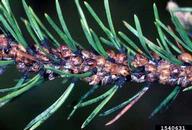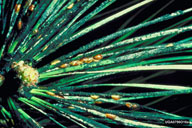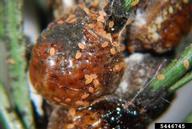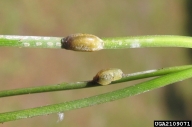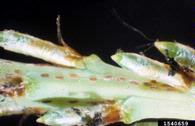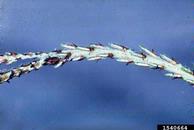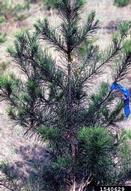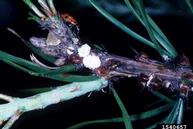Pine tortoise scale
Toumeyella parvicornis (Cockerell) (Hemiptera: Coccidae)
Orientation to pest
The pine tortoise scale, Toumeyella parvicornis (Cockerell), is native to the United States and is found widely over the northeastern, north central, and southeastern portions of the country. It is also invasive in Puerto Rico and the Turks and Caicos Islands in the Caribbean. It has one generation per year in the northern parts of its range, and four or more generations in the southern portions. The first instars (crawlers) are the mobile dispersal stage. Crawlers eventually settle either on the shoot or on the needles. The choice of settling site may be host-specific. Settled females on shoots are brown with dark markings and have the hemispherical tortoise shape for which they are named. Females developing on the needles are elongate and initially are light green with darker green stripes, eventually turning brownish. The males develop on the same plant part as the females. Adult males are winged and smaller than the females. The scales excrete honeydew, which provides a growth medium for sooty mold. Heavy infestations may result in tree mortality.
Hosts commonly attacked
Most pines within its range can be infested by this scale but important hosts include Scotch (Pinus sylvestris), Jack (Pinus banksiana), Virginia (Pinus virginiana), loblolly (Pinus taeda), and slash (Pinus elliottii) pines.
Distribution
This scale is found from eastern New York, south to Florida and west through the Dakotas, Colorado, and Texas wherever its hosts are found. It is also known to occur in Manitoba and Ontario, Canada and has been introduced into parts of the Caribbean.
Images of pine tortoise scale
| Figure 1. Pine tortoise scales; note the tortoise shell shape and color pattern | Figure 2. Sooty mold growing on honeydew excreted by pine tortoise scales on pine needles | Figure 3. Adult (shoot form) of the female pine tortoise scale with emerging crawlers (left) and the needle form female with settled crawlers (right) | |
| Figure 4. Settled crawlers of pine tortoise scale | Figure 5. Young nymphs of pine tortoise scale | Figure 6. Damage to Virginia pine from pine tortoise scale | Figure 7. Ladybird beetles feeding on pine tortoise scales |
Important biological control agents related to this pest species
Many species of parasitoids and predators are reported attacking pine tortoise scale in the United States, and in most settings, natural enemies are sufficient to maintain the scale at low densities. Damaging scale populations develop either when ants tend scale colonies (see Wilkinson and Chellman, 1979) or where dust or insecticides reduce natural enemy numbers in seed orchards or Christmas tree farms (see Clarke et al., 1992).
Web links for information on pine tortoise scale
- Forest Pest Leaflet 57 | USDA Forest Service
- IPM of Midwest Landscapes Fact Sheet | University of Minnesota
Articles
- Wilkinson, R. C. and C. W. Chellman. 1979. Toumeyella scale, red imported fire ant, reduce slash pine growth. Florida Entomologist 62: 71-72.
- Clarke, S. R., J. F. Negron, and G. L. DeBarr. 1992. Effects of four pyrethroids on scale insect (Homoptera) populations and their natural enemies in loblolly and shortleaf pine seed orchards. Journal of Economic Entomology 85: 1246-1252.
